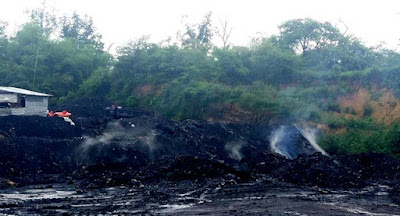Air pollution from Hsipaw coalmine affecting health
Residents in the northern Shan State
township of Hsipaw have been struck by respiratory ailments and other health
issues, including 10 cases of tuberculosis (TB).
 |
| Photo by SHRF: coal mining site in Nam Ma area, Hsipaw Township, northern Shan State. |
Many attribute the crisis to the Nam
Ma coal mine, which, they say, has created severe air pollution over the past
few years, according to a report released on Tuesday by the Shan Human Rights
Foundation (SHRF).
Local villagers have raised concerns
that the recent increase in TB cases is directly linked to years of breathing
in dust and other pollutants from the mine, as well as a longstanding lack of
accessible health care and disease control programs in the area, the report
says.
“Ten villagers [eight men and two
women] from five villages have been diagnosed as suffering from TB by
Hsipaw Hospital, almost all since 2015,” SHRF reported. “Half of the patients
live in Na Koon village, next to the Na Koon coal mine, where digging has taken
place since 2004 and expanded significantly since 2014.”
A 70-year-old patient from Na Koon
village explained to SHRF that he was diagnosed with TB in June 2015. His
illness has caused a great financial burden, he said, as he works as a farmer,
growing corn and cassia. He claimed that before becoming ill, his annual income
from farming was 300,000 kyat (US$220), but due to ill health, he now earns
only about 50,000 kyat a year.
“I have a corn farm about two acres
in size, about 130 meters from the Na Koon coal mining site,” he told SHRF. “Whenever
I go to work at my farm, there is an awful smell from there. I can’t even eat
my meal there due to the awful smell.”
Operations at the large-scale coal
mine are contracted to Ngwe Yi Pale Co. Ltd, a subsidiary of the Ngwe Yi Pale
group. The corporation is also one of the biggest manufacturers of sugar and
cement in Burma. It oversees three mining sites in Shan State: Na Koon; Pieng Hsai and Parng Nga, all of
which are in Hsipaw Township.
 |
| Photo by SHRF: coal mining site in Nam Ma area, Hsipaw Township, northern Shan State. |
Protests by locals forced the
closure of the Pieng Hsai mine in 2015. But operations continue unabated at the
remaining two sites.
On June 29, Shan Herald
reported that more than 600 people in Nam Ma area staged a protest against the Ngwe Yi Pale firm, demanding a suspension
of mining operations in the area.
“We want the company executives to understand the
difficulties villagers are facing and cease their operations,” said Sai Hor
Hseng, a spokesperson for SHRF, speaking to Shan Herald on Tuesday. “We
also urged the villagers to be aware of what is going to happen in their
community. If they know in advance, they can come together to protest against it.
“The government has a responsibility to take care of
its people because it was these people who elected it to represent them. Now
people are suffering; the government must step in and solve these problems.”
He added: “The government must suspend all mining
activities in the country. Now is not the right time for these kinds of
operations.”
Some 1,500 people live in seven
villages in Nam Ma tract, and almost all rely on farming as their main
livelihood. Apart from air pollution, SHRF said, the local coal mine has had
myriad negative effects on the local population, including losses of
agricultural lands; the obstruction and contamination of water sources; and
road accidents involving coal trucks.
By Shan Herald Agency for News
(SHAN)
Tags: Environment, Human Rights, News







